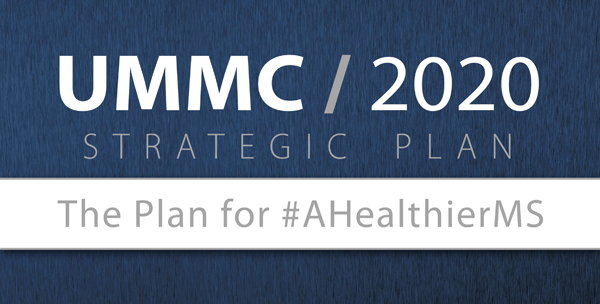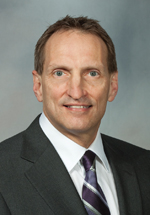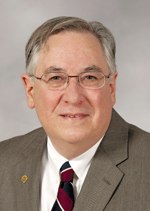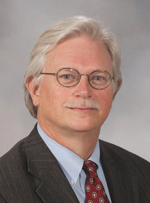2020 Vision: New strategic plan emphasizes mission integration, individual performance

Published in News Stories on January 12, 2015
For many, a strategic plan is like a GPS hidden away in your glove compartment: sure, it can tell you how to get where you want to go, but first you’ve got to dig it out and switch it on.
The Medical Center’s new strategic plan is so innovative and inclusive, administrative leaders fully expect UMMC faculty, staff and students will not just plug into it, but turn up the volume.
What makes this version of a strategic plan – dubbed “UMMC/2020” – so compelling is its scope: unlike previous plans that primarily focused on the institution’s three mission areas separately, this five-year plan emphasizes the integration of UMMC’s health-care, research and educational programs into one cohesive effort.

Woodward
And, according to Dr. LouAnn Woodward, associate vice chancellor for health affairs and vice dean of the School of Medicine, the plan is entirely dependent upon the performance of each and every Medical Center employee and student.
“As the only academic medical center in Mississippi, we are truly the only organization in this state that can have a tremendously strong impact on health, the economy and education for Mississippi,” Woodward said. “For us to be successful in achieving this very ambitious goal, it is important for every employee, faculty member and student to understand their role in advancing our strategic plan.
“The goals of the strategic plan will not be accomplished by a select 25 or 50 people. It will take all of us working together. But it can be done, and it can be done here.”
For more than a year, a Strategic Plan Steering Committee of institutional leaders, appointed by the Medical Center’s Office of Governance and Strategic Planning and guided by a Strategic Plan Core Team representing each of the institution’s missions, met to develop the plan. It consists of six guiding principles – each supported by strategic goals and associated strategies – to ensure the institution maintains its stated vision of being “a premier academic health sciences system that is recognized nationally for high-quality clinical care, for innovative research and for training committed health-care professionals who work together to improve health outcomes and eliminate health disparities.”
“The intent of the strategic plan is to provide a blueprint for the future,” Woodward said. “The future delivery model of health care is changing, and we don’t know exactly what that landscape will look like in three-to-five years.
“It is the intent of the committee that the strategic plan is a living document, not an item to be put on the shelf and collect dust. As such, there will be components of the plan that are constantly under analysis and will need to be tweaked over time.”

Whitfield
According to Candice Whitfield, director of governance and strategic planning, this “interactive road map to the Medical Center’s future” was produced in a transparent and inclusive manner with the input of stakeholders representing every mission area. And, she said, the timing could not have been better.
“We’ve made vast improvements at UMMC over the past five years – everything from financial solvency to image and quality of physicians and staff,” Whitfield said. “With all these strong elements in place, the future destination of the institution has never been more important.
“A strategic plan may not seem exciting or glamorous, but it’s necessary to get people engaged and invested. This is our UMMC, this is where UMMC wants to go in the next few years, and we need everyone’s help to get there.”
The plan contains 10 strategic goals that elucidate how every institutional position has a valued role in helping the Medical Center achieve its goals – everything from cultivating an engaged, effective, professional and diverse workforce and leadership team to promoting a culture of patient- and family-centered care and creating an environment of scholarship, trust, accountability, equity, safety, quality and service excellence – while describing the interrelated purpose of all three mission areas.

Stringer
Dr. Scott P. Stringer, professor and chair of otolaryngology and communicative sciences who serves as chair of the Strategic Plan Committee charged with implementing the plan, said workforce buy-in is critical to the plan’s success.
“By adopting this plan, we have identified the priorities in each of our mission areas that will help us best meet the needs of our patients, learners and stakeholders,” Stringer said. “Engagement of everyone in the organization behind a clear and compelling plan is necessary to make the plan relevant and useful.
“The role of the committee is to help take the plan from a set of aspirational goals on a piece of paper to reality. The committee serves to keep us on track to implement the plan and reach our goals by monitoring progress, continually assessing the relevance of the plan and assisting our plan champions in executing the tactics required for success.”
Those tactics include a healthy focus on an educational enterprise that is in the midst of tremendous change, according to Dr. Ralph H. Didlake, associate vice chancellor for academic affairs and chief academic officer.

Didlake
“This strategic plan comes at a time when curriculum delivery is changing, how we teach is changing rapidly,” Didlake said. “There’s more online instruction, fewer lectures, more experiential-type activity. Converging with that is the rapid evolution of health-care delivery models.
“The health-care providers and other professionals we are training today will work in very different venues and modalities than in the past. There is a greater focus on ambulatory care and inter-professional team care. The strategic plan gives us the perfect opportunity to look at the convergence of those two things and determine how this institution can best educate tomorrow’s health-care professionals.”
He said the educational element of the plan fully integrates components of all three of the institution’s stated missions.
“Our educational activities are dependent upon clinical preceptor sites for student and trainee experiences in real-world settings. The strategic plan process allowed us to look at those things in tandem, not only how to deliver better care, but how to insert our students into those areas in order to teach better care.
“Our graduate school also is involved in the education of tomorrow’s bioscience investigators. The opportunity to sit down with the research community and the clinical community and talk about how to take both and move forward in a parallel way was tremendous. We have just as much of an obligation to provide high-quality scientists and investigators as we do high-quality health-care providers.”

Summers
An important factor in developing high-quality investigators lies in a robust discovery enterprise that includes a healthy focus on translational research, according to Dr. Richard Summers, associate vice chancellor for research.
“We’ve had a strong history in basic science at this institution, but we haven’t done well in developing clinical research in the past,” Summers said. “The strategic plan will help us move forward with building a clinical research enterprise while at the same time maintaining and continuing to support what we’ve done on the basic science side.
“We want to build networks between the basic science and clinical researchers such that they can work together and find common ground in their research. We want to move away from the notion of looking at basic science and clinical science in silos, but integrating the two entities to support our research endeavor. A great mechanism to achieve that is through translational research.”
Woodward said the strategic plan reflects an exciting time for clinicians, educators and investigators to be engaged at this institution.
“There have been many changes at the Medical Center in the last several years,” Woodward said. “There has been a transformation at every level. The strategic plan will guide us as we move into the future and truly begin to link our missions together so that we can accomplish the goal of improving health in Mississippi.”


